This article is the second in a two-part series. Click here to read Part 1!
Endgame: Solo Win Run #1
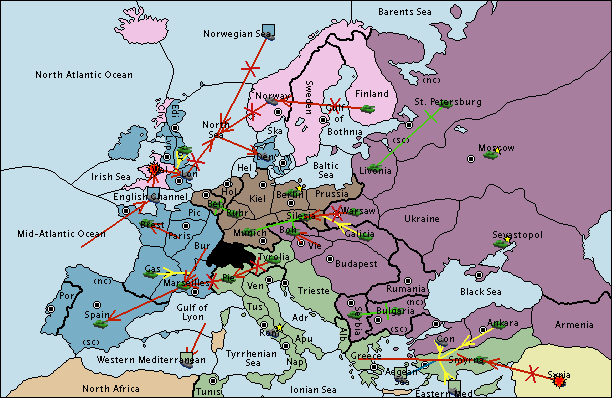
Having regained St. Petersburg, and perceiving Italy’s position as one highly vulnerable to a potential Russian attack, I decided to backstab my ally Italy and go for the win.[1]I fully appreciate that I used and abused my Italian ally. The Italian player showed me a great deal of trust, and I rewarded that trust by plunging a knife into their back. Earlier in the match, I considered Italy a good choice for my ally precisely because I thought I might get such an … Continue reading Starting at a mere 11 supply centers, I would need seven captures to solo win. What was my plan?
I was pretty sure that I would never win if I never built new Northern fleets, so I had to take three simultaneous gambles:
- Gamble that I would outplay Italy for Smyrna, Greece, Trieste. This seemed like a wise gamble because Italy would be starting from a rather poor tactical position if my backstab worked.
- Gamble that I would be able to use those captures to build new Northern fleets. Because it is not possible to build from a supply center that is currently occupied (even if the center is occupied with your own unit), I knew building in St. Petersburg would not be simple. I would have to leave St. Petersburg open at the end of the Autumn turn in order to build from it! This seemed highly risky…but I couldn’t think of any other path to victory.
- Gamble that France wouldn’t somehow be the one to solo. France’s tactical and strategic position was strong—at least as strong as mine. All else being equal, France is the stronger Gunboat power. I was nervous that the net result of my attempt to solo would be France sneaking into Tunis, destroying Germany, and rolling up the North for 18 centers. However, I thought to myself, “the Italian and German both seem pretty savvy; if I attempt a solo and it goes badly, I can probably make peace with them and set up a stalemate against France. I don’t think they will throw the match to France, intentionally or accidentally.” I also hoped that Italy or Germany might interfere with France during the first leg of my solo win run. I decided to take the gamble.
Boom:
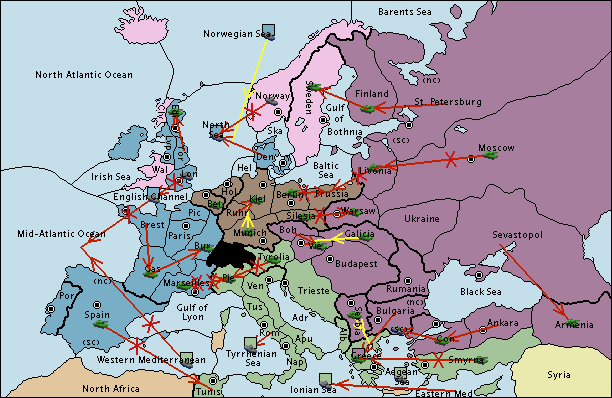
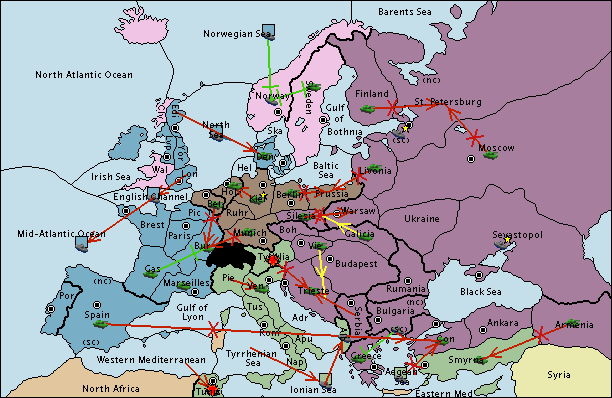
I was not quite able to take every eastern center from Italy (Italy retained Smyrna), but I did achieve a crucial goal: I successfully built a fleet in St. Petersburg.
Do. Not. Underestimate. How. Important. That. Fleet. Is.
Having even one fleet in the North lets Russia break up all sorts of defensive positions that would stalemate Austria or Turkey. Northern fleets also make it possible for Russia to count Northern centers like Sweden or Denmark towards the needed 18 total centers. A Northern fleet presence is key to offsetting Russia’s inability to capture all the Southern centers (e.g., Tunis, Rome).
What about the France situation though?
Crap. France.
My gamble regarding France went poorly. Germany and Italy did not impede France, and instead threw everything they had at me. To my dismay, even England attacked me (causing the remaining English centers to be absorbed by France).
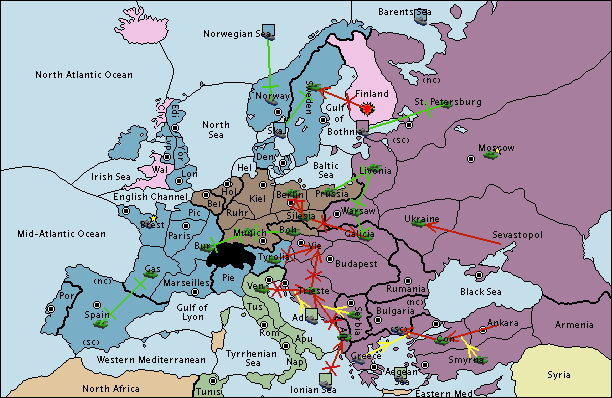
Although there was no chance of my rivals eliminating me, my solo win prospects looked rather grim from this position. And there was a growing danger of a French solo win run.
I put up my draw vote. (The rules for this match required public draw votes, so my vote was a signal to the other players.) I couldn’t see a way to advance by attacking; if anything further Russian attacks might empower France to backstab Germany and/or Italy!
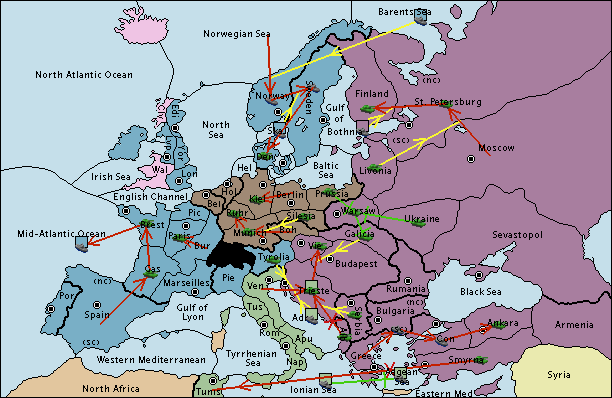
In addition to my draw vote, I knew I had to send signals with my actions. I backed off from fighting Italy, inviting Italy to have Greece. (Italy ended up taking Trieste instead, but that was all the same to me.)
I signaled peace with Germany, who at this point already realized that the lack of French vote was the obstacle to a drawn game.
France did, indeed, initiate a solo win run—or at least seemed to be doing so. (I can imagine that the player might have wanted only to eliminate Germany from the draw; we were playing according to draw-sized scoring rules). Either way, Italy and Germany reacted to these developments and moved to block France (perhaps to set a stalemate line).
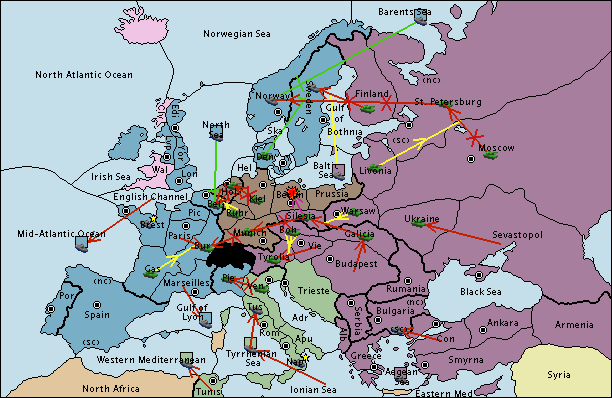
I understood that even though my draw vote was up, I still had a shot at a solo win. I crept up closer and closer to Italy and Germany, pretending (to the extent one can pretend in a Gunboat game) that I was setting up a stalemate line against France.
Counting to 18
Looking at the Autumn 1915 board, I thought to myself, “If the other players don’t see a stab coming, I can win this.” I did not have an exact idea of what my 18 centers would be. I knew I could retake Trieste and defend my gains in the South, but that would only add up to 13 Southern supply centers. In addition to my 1 Northern center (St. Petersburg), I would have to capture 4 more. Where might the other 4 come from? Here is my list, in a rough order of how likely I thought I would be to succeed:
- Berlin. Berlin was mine for the taking. Germany disbanded the army at Berlin, leaving the center undefended. My fleet at Baltic Sea gave me a big tactical advantage in taking and holding Berlin. France was a bit over-extended and/or poorly positioned. France had an army in Denmark, which limited France’s tactical options.[2]A fleet at Denmark might be used to cut Baltic Sea’s support, or potentially work with Sweden to dislodge Baltic Sea. An army at Denmark was much less threatening. France also had many units committed to defending Scandinavia. I was putting as much pressure on that area as I possibly could, which meant France would not be able to use those units for other purposes.
- Munich. I thought I had a pretty good chance of seizing Munich with a surprise attack. I already had three armies in no-man’s-land for “defending” Munich against France, and my positions probably didn’t alarm Germany. I thought it was likely that either France, Germany, or both would move in such a way that I would be able to successfully attack Munich.
- One or Two More Northern Centers. It was hard for me to make a specific prediction of what center I might take, but I considered Sweden, Denmark, Kiel, or maybe even Norway somehow. At the time, I was thinking that my success or failure here would depend on whether I launched a second Northern fleet. Leaving St. Petersburg open during the builds phase would not be easy, since France was bearing down on St. Petersburg from Norway and Barents Sea. I concluded I would have to outplay France in a major way here to capture two Northern centers.
- Venice. I figured that because Italy had only one army and most of their fleets positioned to face France, I had a shot at Venice. However, with just two fleets of my own able to challenge Italy (any new fleet build in Sevastopol would probably be too far away to matter), I concluded that I would have to outplay Italy in a major way. Somehow I would have to simultaneously defend Greece/Aegean Sea and attack Venice with fleet support. And if I lost Greece or Smyrna, then that would negate the point gained from conquering Venice.
I had a path to 18 centers, but it was not an easy one.
One of my core attitudes as a Gunboater is that I have faith that my rivals will make mistakes—and faith in myself that I will take advantage of these mistakes! Somewhere, they will make a poor move choice. Somehow, I will guess the correct counter to their moves. I have had solo wins handed to me just because my rivals were irritated with each other, or just because they didn’t understand how to form the stalemate line. If I can see how my solo win is still possible—now matter how difficult—I keep trying to win.
I also felt like I did not have much to lose. Even if I my attack were halted at 16 or 17 centers, probably Germany would be eliminated and I would get a 3-way draw. I knew there was a chance that Italy might decide to throw the match in frustration at my repeated backstabs, but my sense at the time was that I could, if necessary, cede centers to Italy (again) if my solo win attempted stalled out.
Endgame: Solo Win Run #2
Boom:
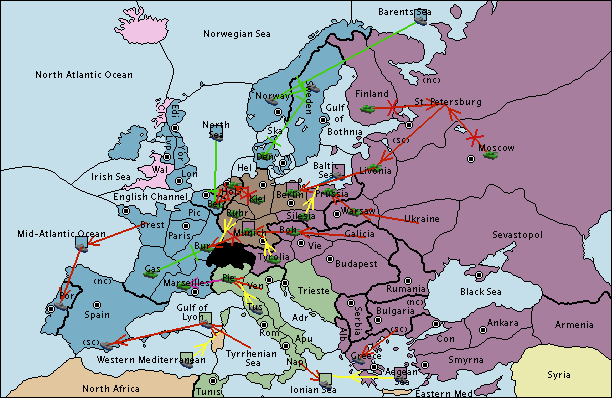
My attack on Germany looked effortless and crushing. Italy misread the situation and committed further against France![3]I cleverly waited until seconds before the end of the turn to take down my public draw vote. Because France was not publicly voting draw (and I was), I anticipated that Italy and Germany would fight France instead of me. But I also needed to prevent France from immediately voting draw and ending … Continue reading
With the stab going my way, I looked hard at the board for my best opportunities. I did not yet have 18 centers in hand, but they seemed within my reach.
- I anticipated that France and Germany would not cooperate to defend Kiel against further attacks. I could see that there were only a few very specific ways for France and Germany to counter an attack on Kiel, and I did not think they were likely to enter those orders. I anticipated that France would just try to finish off Germany, or that France would prioritize a different defense, or that Germany would focus on advancing forward instead of holding Kiel (to have a hope of making it into a draw).
- I knew I could build that second fleet in St. Petersburg if I could just get one correct guess against France. This would be a difficult read, but, it was possible for me to succeed!
- Italy’s fleets were too far away to fight me for Greece/Aegean Sea and defend Venice, so I just needed to anticipate how Italy would move Ionian Sea. If I countered Italy’s move, I would hold the south for a year or two—and possibly set up for the capture of Venice as well.
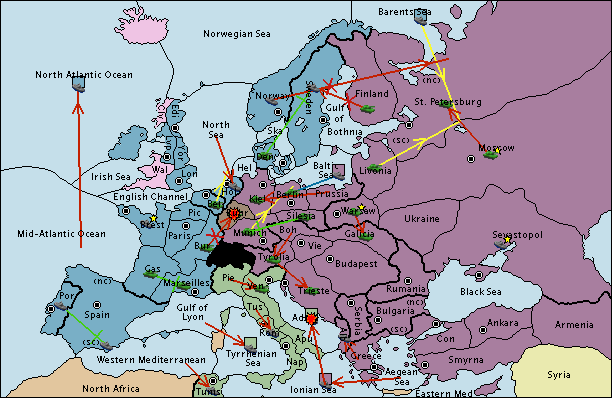
I entered my orders according to my intuitions. What were those intuitions and how well did they serve me?
I attacked Kiel with a clever convoy—and it worked!
I realized that if I convoyed Prussia to Kiel supported by Munich and Berlin, the only way I could be stopped was by France and Germany somehow cooperating to put enough support-holds on Kiel. I thought this rather unlikely, since I read the French player as either a little bit greedy or particularly keen on reducing the size of the draw.[4]Among other reasons: during my first solo win run, I watched France divert resources from stopping my advance to finish off England. And anyways, what did I have to lose in trying?
Sure enough, France attacked Germany, ensuring that my attack on Kiel succeeded.
By the way, my having units lined up in Kiel, Baltic Sea, Finland and St. Petersburg, matched with France’s very loose control of Scandinavia, meant that I would have an opportunity to attack Denmark or Sweden on the following turn! My success in taking Kiel meant that I might reach 18 centers without gaining Venice!
My far-sighted effort earlier in the match to rebuild a fleet in St. Petersburg paid off handsomely. That fleet’s presence in the Baltic Sea created tactical dilemmas for France and Germany that were challenging for them to counter. More specifically, the fleet made it possible for me to capture Kiel and to threaten to capture Sweden or Denmark—centers that are typically well-out-of-reach for other Southern powers (Italy, Austria, and Turkey).
I supported Moscow to St. Petersburg—an incorrect guess
I thought France would make a supported attack on St. Petersburg. To counter that, I supported Moscow to St. Petersburg (anticipating that we would bounce each other). I read France as having a rather simple tactical approach. I thought France would attack St. Petersburg to try to reduce my center count. I was dead wrong.
In fact, France made a really clever counter-move of supporting Moscow to St. Petersburg while also moving Norway to St. Petersburg. France’s counter-play would have beaten me if:
- I self-bounced in St. Petersburg using Moscow;
- I moved Moscow to St. Petersburg without support;
- I made a supported move to St. Petersburg (which is what I did); or
- had simply left St. Petersburg open.
Jeez! The only way for me to counter France’s harassment of St. Petersburg would have been to move either Finland or Livonia—alone—to St. Petersburg. Well played, France. This was a difficult line of play for me to even think up. Your tactical choice was extremely likely to prevent me from building another fleet in St. Petersburg, frustrating one of my major goals.
A quick aside…
I mentor many Diplomacy players, particularly for Gunboat Diplomacy. We talk via email, Discord, etc.—and some of us meet up each Saturday at my “Diplomacy Dojo” video seminar! If you have a suggestion for a topic, want an invite to the Diplomacy Dojo, or just want to get to know me better, contact me!
And if you would like to show your support, why not become one of my Patreon patrons? I went nuts the other day when I got my first patron…
I read Italy like a book…
One of my techniques for succeeding in Gunboat Diplomacy is to make specific predictions of what each player will do with their pieces each turn. If you’ve read my Gunboat Journal, you are familiar with this technique.
As I got closer to initiating my first solo win run, I shared my turn-by-turn predictions with one of my Gunboat students who was following the match. You’ll have to take my word for it, but turn-after-turn I was making specific and accurate predictions of how the Italian player would move their pieces. I assure you, dear reader, that these were by no means easy or obvious predictions; my follow-along student found it challenging to understand my reads, because the Italian player’s thinking was just so different from how my student would have analyzed the situation (had my student been in Italy’s position).
Indeed, I would have made very different choices from the Italian as well. But my predictive mental model for a rival Diplomacy player is not “what would I do in this situation?”—it’s “what would this player do in this situation?”
The Italian player had many reasonable tactical options for how to use the fleet in Ionian Sea to interfere with my solo win run. (For example, the Italian might have moved the fleet to Eastern Mediterranean Sea in order to capture Smyrna and hold down my supply center count below 18; this is what my student said they would have done.) But my ability to read this player was just so strong. I said “The Italian is going to move the fleet to Adriatic Sea.” I felt 99% confident in this read. Let me show you the map a second time so you don’t have to scroll up…

Because I guessed correctly about how Italy would move that fleet, and because France did not move Marseilles to Piedmont, my capture of Venice became inevitable. Combined with my successful move against Kiel, I had achieved a solo win (although I technically required a 1-year victory lap to actually capture Venice).
The Final Count
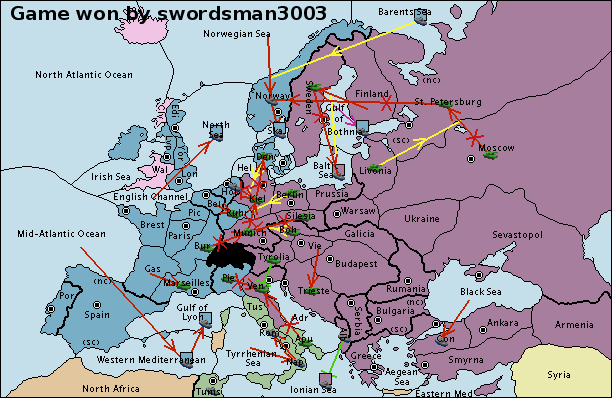
Although I did capture Sweden, that was my 19th center and not necessary to solo win. I already “won” in 1916. I captured Sweden gratuitously to prove to myself that I might have won even if I had not reached Venice (or had lost Smyrna).
At the end of 1916, I knew my 18 centers would be:
- The 13 Southern centers I knew I could get (3 Southern Russian home centers, 3 Turkish home centers, 3 Austrian home centers, 4 neutral Balkan centers).
- 4 Northern centers (1 Northern Russian home center, 3 German home centers).
- 1 stretch-goal Southern center (the Italian home center Venice).
Let’s compare my result in this match to my Russian Gunboat solo win strategy map:
Not bad, eh? Russia typically wins with substantial progress into Scandinavia, but I was shut down by England so early in the match that making gains there was very difficult for me. I made up for this major setback by consolidating control of the entire South (sans Italy), taking all the German home centers as the opportunity arose, and stretching for Venice to reach 18.
Final Thoughts

I’ll be honest, it felt awesome when I was approaching a solo win as Russia in a game of Gunboat Diplomacy—especially after such a frustrating start, and especially in a high-level game! When I finally won, I felt giddy. For years I have been striving to improve my ability at Gunboat Diplomacy, and winning this match feels to me like some evidence that my efforts are working.
Among the reasons I struggled so hard to win the match was that I wanted to prove—definitively—that Russia is not an F-Tier power. I wanted some hard evidence, some proof by personal experience, that Russia can indeed solo win in a Gunboat game against skilled opponents through good-quality play. Although it was by no means easy for me to win, my solo win did not feel miraculous; I just played a good game and so I was able to win.
Your Bored Brother’s Lessons
For your, dear reader, here are some core lessons on what is required to solo win a high-level match of Gunboat Diplomacy:
You must play to the strengths of the power you have been assigned, and find a way to mitigate that power’s weaknesses. Playing the same strategy no matter what power you are assigned is a grave error. Each power has inherent geographic limitations, and in Gunboat Diplomacy (compared to Press Diplomacy) those limitations are intensified because you can’t negotiate your way into unusual positions. Study the board, study the powers, and pursue a strategy that is viable for the power you have been assigned.
You must “play the hand you are dealt.” In a Gunboat game, what happens during early game is difficult to influence (or for Spring 1901, impossible!). But by mid game—if you are paying attention!—you should have a sense of each player’s strategy and personality. Continuously assess the board as it develops and adjust your strategy according to the match as you find it. Pick the right allies and realistic goals.

For example, on this turn I correctly countered almost every move Italy, France, and Germany made. Look carefully at how I took risks in the Balkans area, but nevertheless predicted and countered my opponents’ moves.[5]The exception to my otherwise-excellent read of my opponents was that I missed an opportunity to build a second fleet at St. Petersburg.
You must make a large number of correct guesses about what moves your rivals have entered. You can afford some wrong reads here and there, but by and large your reads need to be correct—especially during the last few turns, which may determine whether you reach 18 or stall out at 15-17 centers. There is just no way around this. No matter how smart you are at the tactics of Diplomacy in theory, you will never win if you cannot read your opponent’s moves correctly most of the time. My favorite technique—one that anybody familiar with my Gunboat Journal would know—is to take a moment each turn to specifically predict how I think each player will move their pieces.
You must take risks. In early and mid game, you have to take risks regarding who to trust and who to attack. You might have to gamble on your own elimination in order to reach a strong mid game position. And in endgame, you might have to risk a rival’s solo win in the process of getting yourself into a potentially winnable position. If you play too conservatively or too defensively, the opportunity to solo win will never appear.
You must think strategically. If your goal is to get a solo win, you must figure out where your 18 centers are going to come from. Look at the board and count up the centers you think you can get, and then think backwards from there to figure out what needs to happen for those centers to become yours. Then make that happen!
Footnotes
| ↑1 | I fully appreciate that I used and abused my Italian ally. The Italian player showed me a great deal of trust, and I rewarded that trust by plunging a knife into their back. Earlier in the match, I considered Italy a good choice for my ally precisely because I thought I might get such an opportunity. Welcome to Diplomacy! |
|---|---|
| ↑2 | A fleet at Denmark might be used to cut Baltic Sea’s support, or potentially work with Sweden to dislodge Baltic Sea. An army at Denmark was much less threatening. |
| ↑3 | I cleverly waited until seconds before the end of the turn to take down my public draw vote. Because France was not publicly voting draw (and I was), I anticipated that Italy and Germany would fight France instead of me. But I also needed to prevent France from immediately voting draw and ending the match after seeing what I had done. |
| ↑4 | Among other reasons: during my first solo win run, I watched France divert resources from stopping my advance to finish off England. |
| ↑5 | The exception to my otherwise-excellent read of my opponents was that I missed an opportunity to build a second fleet at St. Petersburg. |


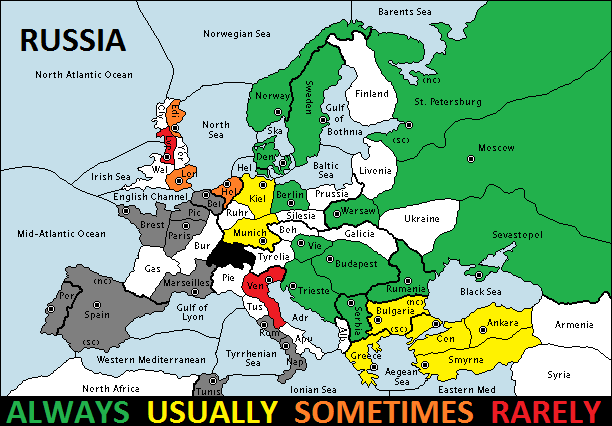
Hi! I loved this article, and I hope to see more of this because it helps me immensely as a player, in fact I think I have a good chance to solo as Russia in a press game. My very first solo in the classical variant! Basically I have chosen strong alliances and have been able to invade Germany, but he had one last trick up his sleeve… But that is not why I am making this comment. I am making it because I am curious why this is not under the tab in Gunboat that says “Country Specific Advice” and I am confused since part one is there, but not this article (which is part two). I honestly think many more people would view this article if you would it with its counterpart under that section. Is this intentional or an accident? I am not sure exactly, but this article is fantastic and deserves the honor of going under “Country Specific Advice”, so I hope you will put it there!
Keep Maintaining Excellency,
Fan of Umble the Heep
Thank you for your kind words! If I understand correctly your question: yes, I made an intentional decision to just hyperlink to “Part 1” In the menu tab for the Country Specific Advice. I figured, if someone reads Part 1, they’ll get to the bottom and see that there’s a part two, and click it?
I am open to your suggestion, since I’m always looking to improve the site’s navigability. I worry that I’ll start running out of space on that tab though. I wonder if there’s another way to make it more clear that this is a two-part piece?
Hi yes I think I do have the answer to make it more clear that this is a two part piece. I think you should edit your first part to include the link to your second article, change the title of it under “Country Specific Advice” so that it says it is part one. Maybe you could just make it one long article and not need for it to be two parts and the issue would be solved. You should be able to come up with more ideas, but this is just what I can think of off the top of my head. Thanks for considering my suggestion. I hope you keep producing fantastic content
Thanks for your suggestions! I’ve updated the first article to include a “visual link” preview to Part 2; hopefully that will make things clearer to the next reader. I’ll consider your point about the header index next time I do an overhaul; I think it needs improvements overall but I haven’t figured out what to do.
Yeah I think that should work. The first time I was reading through part one I missed the link, so I think that should help people to be able to reach the second part.